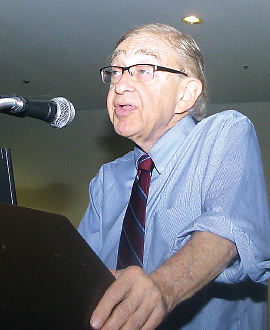Can Neuroscience Explain What Occurs in Addiction Recovery?
Abstract
Findings from functional magnetic imaging of the brain point to a neurobiological understanding of the “spiritual awakening” that many people recovering from alcoholism report from participation in AA.
Participation in Alcoholics Anonymous (AA), the 12-step program of recovery from alcoholism developed more than 60 years ago, works on the neurocircuitry of addiction in ways that might be elucidated by cognitive and brain-imaging studies.
That’s what Marc Galanter, M.D., a professor of psychiatry at New York University, said in the Oscar Pfister Lecture at APA’s 2013 annual meeting in San Francisco in May. In addition to providing evidence that AA achieves success, he discussed ways to understand how participation in AA may act on the neurocircuitry of addiction, particularly with regard to what many successfully recovering alcoholics in AA call a “spiritual awakening.”

Marc Galanter, M.D., points out that part of AA’s success is due to participants’ feeling of “belonging” to the group and that participation has neurobiological effects.
Galanter said that AA uses many of the psychosocial features that operate in any charismatic membership group: social cohesion through attendance at regular meetings; a belief system embodied in the book Alcoholics Anonymous; a behavioral program of action requiring an individual to practice the 12 steps; and an emphasis on cognitive change by altering habits and avoiding “people, places, and things” that serve as triggers for alcohol or drug use.
Galanter said that a feeling of “belonging” is essential to success in AA. “When joining a charismatic group, an individual experiences relief in distress in direct relation to how closely affiliated he or she feels with the group,” he noted.
He outlined seminal studies looking at variables associated with successful long-term sobriety. In one 2006 study of 628 alcoholics in the VA system, successful abstinence at 16 years was related to AA attendance but not to the quantity of medical treatment.
Two 2003 studies found that engagement in AA was not associated with prior motivation or religiosity. But interestingly, while spiritual beliefs at baseline did not predict abstinence at three-year follow-up, a “spiritual awakening” by three years was associated with three-times higher abstinence rates.
A survey of physicians in the organization International Doctors in Alcoholics Anonymous (http://www.idaa.org) found that among those who claimed to have had a “spiritual awakening,” 79 percent reported having no craving for alcohol, compared with 59 percent who had not had such an experience. And those who claimed a spiritual awakening had an average of 155 days sober, compared with 83 for those who had not.
So is it possible to understand at a neurobiological level what is happening when someone undergoes a “spiritual awakening”?
Galanter outlined findings from functional magnetic resonance imaging that show brain areas crucial to alcohol and drug use and addiction, as well as to varied cognitive, emotional, and behavioral phenomena crucial to behavior change. These phenomena include “mirroring” (copying behavior of those with whom one is in close interpersonal interaction), empathy, integration of memories, values, storytelling, and the kind of cognitive dissonance that may occur in a person previously without religious or spiritual orientation who suddenly undergoes a spiritual awakening.
For example, it appears that the hippocampus and dorsolateral prefrontal cortex are key to the acquisition, integration, and retrieval of memories, which may be crucial to communication of one’s own story of addiction in meetings. Some studies suggest that self-disclosure of the kind that occurs in AA meetings when one has a strong sense of belonging may be intrinsically rewarding by activating areas of the mesolimbic dopamine system.
And profound attitude changes may be predicted by activity in the dorsal anterior cingulate cortex and the anterior insula.
In an interview with Psychiatric News, Galanter emphasized that the religious or spiritual dimension of AA and other 12-step programs should not dissuade clinicians from referring patients to AA.
“Successful improvement with participation in AA is not correlated with religiosity at the outset or with greater motivation,” Galanter explained. “So clinicians shouldn’t have to be concerned [about referring] their patients who are not religious or highly motivated. In fact, the best outcomes are associated with greater severity.”
He added that the ubiquitous nature of AA makes it a logical adjunct to medical treatment for a condition that is chronic. “There are over 1 million AA members and 100,000 groups, so it’s a resource that is readily available at any time of the day. Since we have long established that addiction is a chronic illness that is subject to relapse, and since people cannot stay in treatment continuously, we need resources that are not costly and that are viable for the long term.”
He urged clinicians to familiarize themselves with 12-step programs by attending designated meetings that are not “closed” to anyone who does not identify as an alcoholic or addict. “Anyone treating people with any substance abuse problem should themselves have gone to some open AA meetings to get a better idea of what it is like,” Galanter said. “But fewer have had that experience than one would think relative to the benefits, so I would recommend this to our [APA] members.” ■
To listen to an audio interview with Galanter, go to http://www.psychnews.org/update/audio/marc_galanter.mp3.



